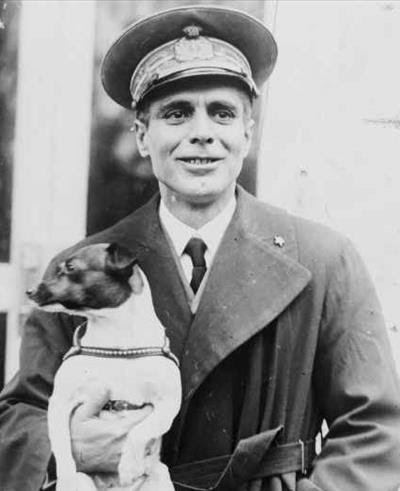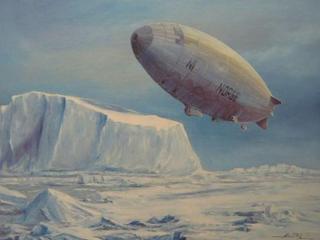Among the film offerings during the 4th of July holiday was the Spirit of St. Louis starring Jimmy Steward as aviator Charles Lindbergh. The title referred to the name of the plane Lindbergh flew solo across the Atlantic.
That plane wasn’t Lindbergh’s first choice. He wanted a Wright-Bellanca, a single-wing aircraft designed by Italian American Giuseppe Bellanca. Unfortunately, the deal fell through. But that same Bellanca made the Atlantic crossing—with a passenger—only a few weeks after Lindbergh, actually flying 315 more miles to Germany instead of Paris, setting its own world records.

and fellow traveler Titina, 1926
Giuseppe Bellanca was Sicilian-born and among a legion of Italian aviators—from south and north—who pioneered flight in the 1920s and 1930s. Those were heady days for Italic people on both side of the Atlantic. Italian pilots were breaking records monthly: in speed, altitude, and distance, as single pilots or in group formations. The world was in awe of Italian aviation, it showcased the Fascist transformation of Italy. It was Mussolini’s goal to remake the image of Italians from cooks and opera singers into daredevils and warriors. He required that all record-seeking aircraft be Italian-made with Italian instruments and engines. In so doing Italy became further industrialized and exporter of aviation products around the world.
Italian aviation wasn’t restricted to fixed wing aircraft. In the 1920s, Neapolitan aviator Umberto Nobile developed a superior dirigible for use by the military and civilians. Sadly, his first sale to the U.S. Army in 1922, christened Roma, ended in disaster when the hydrogen airship stuck a power line and exploded killing 34 airmen. But later test flights proved so successful that Norwegian explorer Roald Admundsen and American financier Lincoln Ellsworth contracted with Nobile to build a dirigible to reach the North Pole. (Admundsen had been the first to reach the South Pole by dog sled in 1911.)

Nobile not only designed and built the dirigible, christened Norge (Norway in Italian), but piloted it. The journey in 1926 was an unqualified success despite frustrating weather conditions. The Norge actually traveled across the Arctic and landed in Alaska, the first trans-Arctic flight in history. While hovering over the North Pole the crew dropped Italian, Norwegian, and American flags onto the ice. Only days before, American explorer Richard Byrd claimed to have reached the Pole by seaplane. However, his claim has been judged a downright fraud. Nobile and Admundsen were the first.
The success of the Norge was only a partial Italian enterprise, as the trip was sponsored by the Norwegians and Lincoln Ellsworth. To confirm Italy’s place in Arctic exploration, Nobile built a new airship christened Italia to land at the North Pole. The all-Italian venture did not have the full support of Nobile’s fellow officers in the Italian Air Force. In particular, his superior, General Italo Balbo, didn’t think much of dirigibles. Consequently, Balbo and Mussolini gave minimal support.
The expedition left Norway in May, 1928 and reached the North Pole only to encounter stormy weather. The Italia broke up midair, half the crew crashed-landed when the gondola separated from the gas envelop. Six of the crew were carried away by the gas envelop, never to be found. Of the ten gondola crewmen, one died on impact and the others were badly injured—Nobile had broken a leg, arm, and rib. Yet, they managed to secure food, a tent, and a radio from the gondola.
The survivors spent a month on the ice while transmitting an SOS daily. Would-be rescuers died trying to locate them. A French airplane carrying Roald Admundsen disappeared in the attempt. When a Swedish plane located the Italians, the pilot ordered Nobile out first. The general protested but had no choice. When the Swedish pilot returned for another survivor his plane crashed, leaving him stranded with the remaining survivors. Eventually, a Russian ship rescued them all.
Nobile’s Arctic venture was a disaster Fascist Italy did not abide. He returned to Italy a hero to the masses but officially he was blamed for abandoning his crew. He resigned his commission in 1929. After Mussolini was overthrown, the Italian government exonerated Nobile and restored his rank. He died in Rome in July 1978, age 93.
Balbo would go on to accomplish a greater Italian feat, leading a squadron of 24 seaplanes across the Atlantic to the Chicago World’s Fair on July 15, 1933. -JLM




Recent Comments